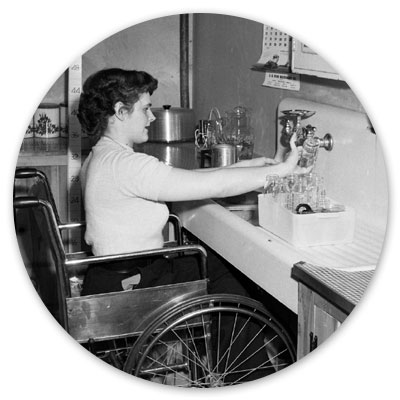Disability in the affluent society
From rehabilitation to universal design
DOI:
https://doi.org/10.24310/Idiseno.2020.v15i0.10307Keywords:
disability, universal design, güte form, polio, Ronald Mace, Selwyn GoldsmithAbstract
After World War II, a period of economic growth began reaching, with fluctuations, to 1973 oil crises. Those years, of the affluent society in Galbraith's words, were not free from health tragedies: polio, flu (in its various forms), and later AIDS, affected the entire planet. Medical advances allowed many people to overcome diseases but did not prevent their consequences.
Any permanent disability affects the life of those who suffer it, not only because it prevents them from doing essential things, but also because of social rejection that, to a greater or lesser extent, they may suffer. The way in which public space is organized, the architecture that occupies it and the objects we use are more responsible for disability than the illnesses or accidents suffered by those affected. The role of design in this complex framework is so contradictory that it can be the solution to many problems, but also the cause of many of them.
This article reviews the circumstances that led to the formation of movements in favor of accessibility and their role in the development of a legal framework to people with disabilities. It analyzes the influence of hygienism and eugenics in design and deals with the difficulty of conventional design to meet the needs of people with disabilities.
Downloads
Metrics
References
Berciano, José. (2017) Franklin D. Roosevelt pudo tener un síndrome de Guillain-Ba¬rré. Madrid, Centro de Investigación Biomédica en Red sobre Enfermedades Neurodegenerativas.
Bürdek, Bernhard E. (2019) Diseño. Historia, teoría y práctica del diseño de produc¬to. Madrid: Experimenta.
Le Corbusier. (1925a) L’Art décoratif d’aujourd’hui. París, Éditions Crès, colección L’esprit nouveau.
Le Corbusier. (1925b) Urbanisme. París, Éditions Crès, colección L’esprit nouveau.
Cogdell, Christina. (2003) «Products or Bodies? Streamline Design and Eugenics as Applied Biolog», en Design Issues, vol 19, nº 1, invierno de 2003.
Davis, Lennard J, (2002) Bending Over Backwards: Essays on Disability and the Body. Nueva York. New York University Press.
Dreyfuss, Henry. (1955) Designing for People. Nueva York, Simon & Schuster.
Dreyfuss Associates y Alvin R.Tilley. (1993) The Measure of Man and Woman. Hu¬man Factors in Design. Nueva York, Whitney Library of Design (Primera edi¬ción: The Measure of Man, 1959).
Erni, Peter (1993) Die Gute Form: Ein Programm des Schweizerischen Werkbundes. Zúrich, Lars Müller.
Forty, Adrian. (1980) «The Modern Hospital in England and France: The Social and Medical Uses of Architecture», en King, Anthony. ed. Buildings and Society. Londres: Routledge & Kegan Paul.
Goffman, Erving. (1963) Stigma: Notes on the management of spoiled indetity. Englewood Clifts, NJ: Prentice Hall.
Goldsmith, Selwyn. (1997) Designing for the Disabled: The New Paradigm. Oxford, Architectural Press.
Goldsmith, Selwyn. (2000), Universal Design: A Manual of Practical Guidance for Architects, Architectural Press.
Guffey, Elizabeth. (2018) Designing Disability Symbols, Space, and Society. Londres, Nueva York, Bloomsbury Academic.
Hamraie, Aimi. (2016). «Universal Design and the Problem of Post-Disability Ideolo¬gy», en Design and Culture, Volumen 8, nº 3, 2016.
Hamraie, Aimi. (2017) Building Access Universal Design and the Politics of Disabili¬ty. Building Access Universal Design and the Politics of Disability. Minneapolis, University of Minnesota Press.
Jennings, Audra R. (2008) With Minds fixed on the Horrors of War: Liberalism and Disability Activism, 1940-1960. Tesis doctoral presentada en la Ohio State University.
Kaes, Anton. (1992) From Hitler to Heimat. The Return of History as Film. Cambri¬dge, MA, Harvard University Press.
Mace, Ronald. (1985) «Universal Design: Barrier Free Environments for Everyone», en Designers West, noviembre de 1985.
McKeown, Thomas. (1988) The Origins of Human Disease. Oxford, Basil Blac¬kwell (Edición española: Los orígenes de las enfermedades humanas. Crítica. Barcelona, 1990).
Meikle, Jeffrey L. (2001) Twentieth Century Limited. Industrial Design in America, 1925·1939. Filadelfia, Temple University Press. Philadelphia.
Naciones Unidas. (2006) Convención sobre los derechos se las personas con disca¬pacidad.
Nugent, Timothy J. (1960) «Design of Buildings to permit their use by the Physi¬cally Handicapped. A National Attack on Architectural Barriers», en New Buil¬ding Research. BRI Publication 910, otoño de 1960. Washington, DC, Building Research Institute.
Oshinsky, David M. (2005) Polio. An American Story. Nueva York. Oxford Univer¬sity Press.
Rusk, Howard y Eugene J. Taylor. (1953) Living with a Disability. Garden City, NY, Blakiston.
Shakespeare, Tom. (2006) Disability Rights and Wrongs. Londres, Routledge.
Snowden, Frank M. (2019) Epidemics and Society. From the Black Death to the Present. New Haven y Londres, Yale University Press.
Spitz, Rene (2002) The Ulm School of Design. A View Behind the Foreground: The Political History of the Ulm School of Design 1953-1968. Berlín: Edition Axel Menges.
Turda, Marius. (2010) Modernism and Eugenics. Basingstoke, Palgrave Macmillan.
Toomey J. Gazette. (1967)
Urban Mass Transportation Administration. (1975) Innovation in Public Transporta¬tion. A Directory of Research, Development and Demonstration Projects. Washin¬gton, US Department of Transportation.
Vega, Pilar. (2006) La accesibilidad del transporte en autobús. Madrid, Instituto de Mayores y Servicios Sociales.
Williamson, Bess y Elizabeth Guffey. (2020) «Introduction: Rethinking Design His¬tory trough Disability, Rethinking Disability trough Design», en Making Disabi¬lity Modern. Nueva York, Bloomsbury Visual Arts.
Williamson, Bess. (2019a) Accessible America. A History of Disability and Design. Nueva York, New York University Press.

Downloads
Published
How to Cite
Issue
Section
License
Aquellos autores/as que tengan publicaciones con esta revista, aceptan los términos siguientes:- Los autores/as conservarán sus derechos de autor y garantizarán a la revista el derecho de primera publicación de su obra, el cuál estará simultáneamente sujeto a la Licencia de reconocimiento de Creative Commons que permite a terceros compartir la obra siempre que se indique su autor y su primera publicación esta revista.
- Los autores/as podrán adoptar otros acuerdos de licencia no exclusiva de distribución de la versión de la obra publicada (p. ej.: depositarla en un archivo telemático institucional o publicarla en un volumen monográfico) siempre que se indique la publicación inicial en esta revista.
- Se permite y recomienda a los autores/as difundir su obra a través de Internet (p. ej.: en archivos telemáticos institucionales o en su página web) antes y durante el proceso de envío, lo cual puede producir intercambios interesantes y aumentar las citas de la obra publicada. (Véase El efecto del acceso abierto).






14.png)



